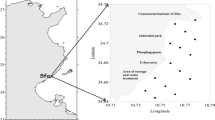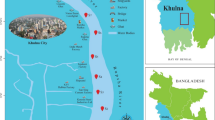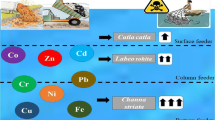Abstract
Fish contamination with heavy metal (loid)s could be a serious threat to human health. In this study, the concentrations of twelve heavy metal (loid)s in the liver, kidney, gills, muscles, skin and bones were determined in five different fishes, collected from the Hainan Island, China. Results indicated that the average concentrations of Fe, Cu, Zn, Cr, Mn, Se, Ni, As, Hg, Cd, Pb and Co in the fish tissues were 75.56, 6.935, 4.76, 4.05, 3.298, 0.981, 0.732, 0.643, 0.585, 0.263, 0.232, and 0.08 mg/kg respectively. Therefore, the hierarchical order of the metal concentrations in fishes observed was Fe > Cu > Zn > Cr > Mn > Se > Ni > As > Hg > Cd > Pb > Co. Findings of our study revealed that the average maximum concentrations of biologically essential heavy metals were found higher than those of biologically non-essential heavy metals. An average maximum Fe content was present in the kidneys of all fish, followed by liver, then gills. However, skin, muscles and bones which are not metabolically active sites for bioaccumulation contained low concentration. Significant positive and negative correlations were observed among the metal pairs. The THQ values for Cr, Cd, and As above 1 indicated a non-carcinogenic risk to human health. Integration of 12 heavy metal concentrations followed the order: metals in benthic fish > metals in demersal fish > metals in pelagic fish. Regular monitoring of the water and fish for heavy metals (loid)s should be done regularly to protect aquatic ecosystem and human health through targeted response measures.



Similar content being viewed by others
Data Availability
The datasets generated during and/or analysed during the current study are available from the corresponding author on reasonable request.
References
Adegbola IP, Aborisade BA, Adetutu A (2021) Health risk assessment and heavy metal accumulation in fish species (Clarias gariepinus and Sarotherodon melanotheron) from industrially polluted Ogun and Eleyele Rivers, Nigeria. Toxicol Rep 8:1445–1460
Akkan T et al (2018) An Examination of Ecological and Statistical Risk Assessment of Toxic Metals in Sediments at Siddikli Dam Lake: A Case Study in Kirsehir, Turkey
Alahabadi A, Malvandi H (2018) Contamination and ecological risk assessment of heavy metals and metalloids in surface sediments of the Tajan River, Iran. Mar Pollut Bull 133:741–749
Ali H, Khan E (2018) Assessment of potentially toxic heavy metals and health risk in water, sediments, and different fish species of River Kabul, Pakistan. Hum Ecol Risk Assess 24(8):2101–2118
Andreji J et al (2005) Concentration of selected metals in muscle of various fish species. J Environ Sci Health B 40(4):899–912
Andreji J et al (2006) Accumulation of some metals in muscles of five fish species from lower Nitra River. J Environ Sci Health Part A 41(11):2607–2622
Andres S et al (2000) Interspecific comparison of cadmium and zinc contamination in the organs of four fish species along a polymetallic pollution gradient (Lot River, France). Sci Total Enviro 248(1):11–25
Annabi A, Said K, Messaoudi I (2013) Cadmium: bioaccumulation, histopathology and detoxifying mechanisms in fish. Am J Res Commun 1(4):62
Atique Ullah A et al (2019) Evaluation of possible human health risk of heavy metals from the consumption of two marine fish species Tenualosa ilisha and Dorosoma cepedianum. Biol Trace Elem Res 191(2):485–494
Bajc Z et al (2005) The contents of Cu, Zn, Fe, and Mn in Slovenian freshwater fish. Slov Vet Zb 42(1/2):15–21
Bangash FK, Alam S (2004) Extent of pollutants in the effluents of Hayatabad Industrial Estate, Peshawar. J Chem Soc 26(3):271–285
Bat L et al (2015) Heavy metal levels in the liver and muscle tissues of the four commercial fishes from Lake Balik, Kızılırmak Delta (Samsun, Turkey). J Coast Life Med 3(12):950–955
Bhattacharya AK, Mandal SN, Das SK (2006) Bioaccumulation of chromium and cadmium in commercially edible fishes of gangetic West Bengal. Trends Tech Sci Res 1:511–517
Bols NC et al (2001) Ecotoxicology and innate immunity in fish. Dev Comp Immunol 25(8–9):853–873
Bonsignore M et al (2018) Bioaccumulation of heavy metals in fish, crustaceans, molluscs and echinoderms from the Tuscany coast. Ecotoxicol Environ Saf 162:554–562
Bosch AC et al (2016) Heavy metals in marine fish meat and consumer health: a review. J Sci Food Agric 96(1):32–48
Brzóska M, Moniuszko-Jakoniuk J (2001) Interactions between cadmium and zinc in the organism. Food Chem Toxicol 39(10):967–980
Burger J et al (2002) Metal levels in fish from the Savannah River: potential hazards to fish and other receptors. Environ Res 89(1):85–97
Burger J, Campbell KR (2004) Species differences in contaminants in fish on and adjacent to the Oak Ridge Reservation, Tennessee. Environ Res 96(2):145–155
de Rezende MG et al (2019) Withdrawal of plasma estradiol is associated with increased anxiety reported by women in the first 12 hours after delivery. Psychoneuroendocrinology 101:67–71
Deb SC, Fukushima T (1999) Metals in aquatic ecosystems: mechanisms of uptake, accumulation and release-Ecotoxicological perspectives. Int J Environ Sci 56(3):385–417
Djikanović V et al (2016) Age-specific metal and accumulation patterns in different tissues of nase (Chodrostoma nasus) from the Medjuvršje Reservoir. Sci Total Environ 566:185–190
Egila JN, Daniel VN (2011) Trace metals accumulation in freshwater and sediment insects of Liberty Dam, Plateau State Nigeria. Int J Basic Appl 11:128–140
EPA U (2000) Guidance for assessing chemical contaminant data for use in fish advisories. Guidance for assessing chemical contaminant data for use in fish advisories, volume 2: risk assessment and fish consumption limits. (2015–06). EPA 823-B-00–008
Fao U (2014) World review of fisheries and aquaculture. State of World Fisheries and Aquaculture: opportunities and challenges. Rome. Food Agric United Nations 1:3–93
Ferguson HW (1989) a Systemic pathology of Fish. A text and atlas of comparative tissue responses in diseases of teleosts
Filazi A et al (2003) Metal concentrations in tissues of the Black Sea fish Mugil auratus from Sinop-Icliman, Turkey. Hum Exp Toxicol 22(2):85–87
Firdous A et al (2021) Toxicity of heavy metals in freshwater fishes: challenges and concerns, in freshwater pollution and aquatic ecosystems. Apple Academic Press, pp 25–51
Fraser M et al (2013) Fish and seafood availability in markets in the Baie des Chaleurs region, New Brunswick, Canada: a heavy metal contamination baseline study. Environ Sci Pollut Res 20(2):761–770
Fu J et al (2013) Risk and toxicity assessments of heavy metals in sediments and fishes from the Yangtze River and Taihu Lake. China 93(9):1887–1895
Green AJ, Planchart A (2018) The neurological toxicity of heavy metals: A fish perspective. Comp Biochem Physiol Part C Environ Toxicol Pharmacol 208:12–19
Gu D et al (2006) Body weight and mortality among men and women in China. JAMA 295(7):776–783
Gu Y-G et al (2018) Non-metric multidimensional scaling and human risks of heavy metal concentrations in wild marine organisms from the Maowei Sea, the Beibu Gulf, South China Sea. Environ Toxicol Pharmacol 59:119–124
Han J-L et al (2021) Health risk assessment of heavy metals in marine fish to the population in Zhejiang, China. Sci Rep 11(1):1–9
Has-Schön E et al (2015) Distribution and age-related bioaccumulation of lead (Pb), mercury (Hg), cadmium (Cd), and arsenic (As) in tissues of common carp (Cyprinus carpio) and European catfish (Sylurus glanis) from the Buško Blato reservoir (Bosnia and Herzegovina). Chemosphere 135:289–296
Hu B et al (2013) Occurrence and distribution of heavy metals in surface sediments of the Changhua River Estuary and adjacent shelf (Hainan Island). Mar Pollut Bull 76(1–2):400–405
Huseen HM, Mohammed AJ (2019) Heavy metals causing toxicity in fishes. J Phys Conf Ser 1294(6):062028
Javed M, Usmani N (2016) Accumulation of heavy metals and human health risk assessment via the consumption of freshwater fish Mastacembelus armatus inhabiting, thermal power plant effluent loaded canal. Springerplus 5(1):1–8
Karsli B (2021) Determination of metal content in anchovy (Engraulis encrasicolus) from Turkey, Georgia and Abkhazia coasts of the Black Sea: Evaluation of potential risks associated with human consumption. Mar Pollut Bull 165:112108
Karuppasamy R (2004) Evaluation of Hg concentration in the tissue of fish Channa punctatus (Bloch.) in relation to short and long-term exposure to phenyl mercuric acetate. J Plat Jubilee AU. 40:197–204
Kaya G, Turkoglu S (2017) Bioaccumulation of heavy metals in various tissues of some fish species and green tiger shrimp (Penaeus semisulcatus) from İskenderun Bay, Turkey, and risk assessment for human health. Biol Trace Elem Res 180(2):314–326
Li F et al (2017) Risk assessment of trace metal-polluted coastal sediments on Hainan Island: A full-scale set of 474 geographical locations covering the entire island. Mar Pollut Bull 125(1–2):541–555
Liu L et al (2015) Global, regional, and national causes of child mortality in 2000–13, with projections to inform post-2015 priorities: an updated systematic analysis. Lancet 385(9966):430–440
Lock RAC, Van Overbeeke AP (1981) Pharmacology, Effects of mercuric chloride and methylmercuric chloride on mucus secretion in rainbow trout, Salmo gairdneri Richardson. Comp Biochem Physiol 69(1):67–73
Marzouk M (1994) Fish and environment pollution. J Vet Med 42:51–52
Mendil D et al (2005) Determination of trace metal levels in seven fish species in lakes in Tokat, Turkey. Food Chem 90(1–2):175–179
Miao X et al (2020) The human impacts level and migration of heavy metals in original inshore sediments of Dongying, China. J Coast Conserv 24(6):1–15
Miao X et al (2021) Effects of heavy metals speciations in sediments on their bioaccumulation in wild fish in rivers in Liuzhou—A typical karst catchment in southwest China. Ecotoxicol Environ Saf 214:112099
Murtala BA, Abdul WO, Akinyemi AA (2012) Bioaccumulation of heavy metals in fish (Hydrocynus forskahlii, Hyperopisus bebe occidentalis and Clarias gariepinus) organs in downstream Ogun coastal water, Nigeria. Int J Sci Technol 4(11):51
Mutlu T (2021a) Heavy metal concentrations in the edible tissues of some commercial fishes caught along the Eastern Black Sea coast of Turkey and the health risk assessment. Spectrosc Lett 54(6):437–445
Mutlu T (2021b) Seasonal variation of trace elements and stable isotope (δ13C and δ15N) values of commercial marine fish from the black sea and human health risk assessment. Spectrosc Lett 54(9):665–674
Pan K, Wang WX (2012) Trace metal contamination in estuarine and coastal environments in China. Sci Total Environ 421:3–16
Peto MV (2010) Aluminium and iron in humans: bioaccumulation, pathology, and removal. Curr Pharm Des 511(1)
Pini JM, Richir J, Watson GJ (2015) Metal bioavailability and bioaccumulation in the polychaete Nereis (Alitta) virens (Sars): The effects of site-specific sediment characteristics. Mar Pollut Bull 95(2):565–575
Rakocevic J, Sukovic D, Maric D (2018) Distribution and relationships of eleven trace elements in muscle of six fish species from Skadar Lake (Montenegro). Turk J Fish Aquat Sci 18(5):647–657
Sfakianakis D et al (2015) Effect of heavy metals on fish larvae deformities: a review. Environ Res 137:246–255
ShaAto R et al (2011) Bioaccumulation of Heavy Metals in Fish (Tilapia Zilli and Clarias Gariepinus) Organs from River Benue, North Central Nigeria. Pak J Anal Environ 12(1 & 2):7
Shukla V et al (2007) Bioaccumulation of Zn, Cu and cd in Channa punctatus. J Environ Biol 28(2):395
Türkmen M, Dura N (2016) Assessment of heavy metal concentrations in fish from south western Black Sea
USEPA (2011) Exposure factors handbook, 2011th edn. Soil and dust ingestion, USEPA Office of Research and Development, Washington
Uwem GU et al (2013) Bioaccumulation of heavy metal in three fresh water fishes caught from cross river system. Eur J Exp Biol 3(3):576–582
Uysal K (2011) Heavy metal in edible portions (muscle and skin) and other organs (gill, liver and intestine) of selected freshwater fish species. Int J Food Prop 14(2):280–286
Varol M, Kaya GK, Alp A (2017) Heavy metal and arsenic concentrations in rainbow trout (Oncorhynchus mykiss) farmed in a dam reservoir on the Firat (Euphrates) River: Risk-based consumption advisories. Sci Total Environ 599:1288–1296
Wan Y et al (2017) Wave energy resource assessment off the coast of China around the Zhoushan Islands. Energies 10(9):1320
Wang C et al (2018) Distribution and transport of heavy metals in estuarine–inner shelf regions of the East China Sea. Sci Total Environ 644:298–305
Wei Y et al (2014a) Metal concentrations in various fish organs of different fish species from Poyang Lake, China. Environ Sci Technol 104:182–188
Wei W et al (2014b) Simple whole-cell biodetection and bioremediation of heavy metals based on an engineered lead-specific operon. Environ Sci Technol 48(6):3363–3371
Yi Y et al (2017) Health risk assessment of heavy metals in fish and accumulation patterns in food web in the upper Yangtze River. China 145:295–302
Yi Y, Yang Z, Zhang S (2011) Ecological risk assessment of heavy metals in sediment and human health risk assessment of heavy metals in fishes in the middle and lower reaches of the Yangtze River basin. Environ Pollut 159(10):2575–2585
Zeitoun MM, Mehana E (2014) Impact of water pollution with heavy metals on fish health: overview and updates. Glob Vet 12(2):219–231
Zhong Y et al (2015) Determination and evaluation of heavy metal content of freshwater economic fish in Northeast Guangdong. Asian J Agric Res 7(1812-2016–144277):61–70
Acknowledgements
This study was financially supported by the Key Research and Development Project of Hainan Province (grant number ZDYF2018122) and Hainan Provincial Natural Science Foundation of China (422RC601).
Author information
Authors and Affiliations
Corresponding authors
Ethics declarations
Conflict of Interest
The authors declare that they have no conflict of interest.
Additional information
Publisher's Note
Springer Nature remains neutral with regard to jurisdictional claims in published maps and institutional affiliations.
Rights and permissions
Springer Nature or its licensor holds exclusive rights to this article under a publishing agreement with the author(s) or other rightsholder(s); author self-archiving of the accepted manuscript version of this article is solely governed by the terms of such publishing agreement and applicable law.
About this article
Cite this article
Ahmad, T., Gul, S., Khan, M.A. et al. Bioaccumulation and Health Risk Assessment of Heavy Metal (loid)s in Different Fish Species of Hainan Island, China. Thalassas 38, 1395–1406 (2022). https://doi.org/10.1007/s41208-022-00474-w
Received:
Revised:
Accepted:
Published:
Issue Date:
DOI: https://doi.org/10.1007/s41208-022-00474-w




